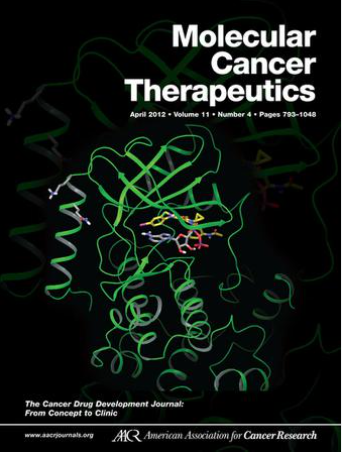Abstract A020: TP53 mutation and prediction of platinum response in BRCA-mutated ovarian cancer: A prospective case-series analysis
IF 5.3
2区 医学
Q1 ONCOLOGY
引用次数: 0
Abstract
Background and aim of the study: Currently, platinum sensitivity (PS) is a prerequisite for first-line PARP inhibitors (PARPi) in locally advanced and relapsed high grade serous ovarian cancer (HGS-OC). BRCA mutations are recognized as predictive of PS and, therefore, of response to PARPi . Notably, platinum and PARPi cytotoxic action is mainly related by their ability of inducing p53-mediated apoptosis. Therefore, the integrity of p53 machinery is crucial for platinum-related activity whereas the presence of p53 mutation is a fairly frequent event in ovarian cancer, particularly in HGS-OC and in BRCA mutated ones. Patients and methods: We prospectively analyzed 208 women with primary ovarian cancer undergoing surgery at the Department of Gynecologic Oncology, ARNAS G. Brotzu, Cagliari, Italy, between 2019 and 2023. Somatic NGS analysis was performed to detect BRCA and HRD mutations. TP53 mutations were classified according to according to hotspot, structural (missense or nonsense) and functional classification as “gain of function” (GOF) or “loss of function” (LOF), based on the IARC TP53 database. Comparative testing with Fisher's exact test was used to examine TP53 mutation distribution and associations with clinicopathologic factors and PS. The BRCA mutation status was further used to stratify the analysis. Results: Globally, we included 127 adult HGS-OC pts. 84.2% had stage III-IV disease. TP53 mutation was found in 83.4 % of the entire cohort. Somatic BRCA mutations were found in 28.3% pts. Overall, HGS-OC with somatic BRCA mutations had higher TP53 mutation frequency (88.8%) when compared to BRCA WT (81.3%, p=0.1510). Employing the structural classification scheme, most cancers harbored a missense TP53 mutation (76.5%). LOF TP53 mutations were found in 59.4% while GOF in 31.2%. No significant disparity was observed in the distribution of specific TP53 mutations within each classification scheme between cases with BRCA mutations and those without. As for BRCA mutated pts, TP53 WT were all PS. Among those p53 mutated, GOF mutations were associated with PS in 7 pts and platinum resistance in 3 pts; LOF mutations were associated with PS in 7 pts and platinum resistance in 12 pts. The difference in distribution of PS between functional categories of p53 mutations was significant (p=0.0291). As for BRCA WT pts, TP53 WT were all PS. Among TP53 mutated, GOF mutations were associated with PS in 14 pts and platinum resistance in 10 pts; viceversa, LOF mutations were associated with PS in 19 pts and platinum resistance in 25 pts, even if these findings were not statistically significant (p=0.2357). Of relevance, in 5 cases where LOF mutations of p53 was associated with null expression of HIC p53, patients were refractory to platinum-based chemotherapy. Conclusions: Even if preliminary, our data show that HGS-OC harboring p53 null mutations are the poorest prognostic subgroup, especially in terms of PS. Further studies are needed to confirm our findings and the role of TP53 mutation as a biomarker of inherent or acquired platinum resistance. Citation Format: Eleonora Lai, Manuela Neri, Elisabetta Sanna, Sonia Nemolato, Fabio Bardanzellu, Mario Scartozzi, Sabrina Giglio, Antonio Macciò, Clelia Madeddu. TP53 mutation and prediction of platinum response in BRCA-mutated ovarian cancer: A prospective case-series analysis [abstract]. In: Proceedings of the AACR Special Conference in Cancer Research: Expanding and Translating Cancer Synthetic Vulnerabilities; 2024 Jun 10-13; Montreal, Quebec, Canada. Philadelphia (PA): AACR; Mol Cancer Ther 2024;23(6 Suppl):Abstract nr A020.摘要 A020:TP53突变与BRCA突变卵巢癌的铂反应预测:前瞻性病例系列分析
研究背景和目的:目前,铂敏感性(PS)是局部晚期和复发高级别浆液性卵巢癌(HGS-OC)一线使用 PARP 抑制剂(PARPi)的先决条件。BRCA 基因突变被认为是 PS 的预测因素,因此也是 PARPi 反应的预测因素。值得注意的是,铂类和 PARPi 的细胞毒性作用主要与它们诱导 p53 介导的细胞凋亡的能力有关。因此,p53机制的完整性对铂类相关活性至关重要,而p53突变在卵巢癌中相当常见,尤其是在HGS-OC和BRCA突变的卵巢癌中。患者和方法我们对 2019 年至 2023 年期间在意大利卡利亚里 ARNAS G. Brotzu 妇科肿瘤部接受手术的 208 名原发性卵巢癌妇女进行了前瞻性分析。进行了体细胞 NGS 分析,以检测 BRCA 和 HRD 突变。根据 IARC TP53 数据库,TP53 突变按热点、结构(错义或无义)和功能分类为 "功能增益"(GOF)或 "功能缺失"(LOF)。采用费雪精确检验进行比较测试,以检查 TP53 突变的分布以及与临床病理因素和 PS 的关系。BRCA 基因突变状态进一步用于分层分析。结果在全球范围内,我们共纳入了 127 例成人 HGS-OC 患者。84.2%的患者处于III-IV期。整个群体中有 83.4% 发现了 TP53 突变。28.3%的患者发现了体细胞BRCA突变。总体而言,与 BRCA WT(81.3%,P=0.1510)相比,体细胞 BRCA 突变的 HGS-OC 具有更高的 TP53 突变频率(88.8%)。根据结构分类方案,大多数癌症都存在错义 TP53 突变(76.5%)。在59.4%的癌症中发现了LOF TP53突变,而在31.2%的癌症中发现了GOF突变。在每种分类方案中,有 BRCA 基因突变的病例和没有 BRCA 基因突变的病例在特异性 TP53 突变的分布上没有明显差异。在 BRCA 基因突变的病例中,TP53 WT 均为 PS。在P53突变的病例中,GOF突变与PS相关的有7例,与铂耐药相关的有3例;LOF突变与PS相关的有7例,与铂耐药相关的有12例。不同功能类别的 p53 突变与 PS 的分布差异显著(p=0.0291)。至于 BRCA WT 患者,TP53 WT 均为 PS。在TP53突变者中,GOF突变与14例PS相关,与10例铂金耐药相关;反之亦然,LOF突变与19例PS相关,与25例铂金耐药相关,尽管这些结果没有统计学意义(P=0.2357)。值得注意的是,在5例p53的LOF突变与HIC p53的无效表达相关的病例中,患者对铂类化疗产生了耐药性。结论:即使是初步研究,我们的数据也表明,携带 p53 空突变的 HGS-OC 是预后最差的亚组,尤其是在 PS 方面。还需要进一步的研究来证实我们的发现以及 TP53 突变作为固有或获得性铂类耐药生物标志物的作用。引用格式:Eleonora Lai, Manuela Neri, Elisabetta Sanna, Sonia Nemolato, Fabio Bardanzellu, Mario Scartozzi, Sabrina Giglio, Antonio Macciò, Clelia Madeddu.TP53突变与BRCA突变卵巢癌的铂反应预测:前瞻性病例系列分析[摘要]。In:AACR癌症研究特别会议论文集:扩展和转化癌症合成漏洞;2024 年 6 月 10-13 日;加拿大魁北克省蒙特利尔。费城(宾夕法尼亚州):AACR; Mol Cancer Ther 2024;23(6 Suppl):Abstract nr A020.
本文章由计算机程序翻译,如有差异,请以英文原文为准。
求助全文
约1分钟内获得全文
求助全文
来源期刊
CiteScore
11.20
自引率
1.80%
发文量
331
审稿时长
3 months
期刊介绍:
Molecular Cancer Therapeutics will focus on basic research that has implications for cancer therapeutics in the following areas: Experimental Cancer Therapeutics, Identification of Molecular Targets, Targets for Chemoprevention, New Models, Cancer Chemistry and Drug Discovery, Molecular and Cellular Pharmacology, Molecular Classification of Tumors, and Bioinformatics and Computational Molecular Biology. The journal provides a publication forum for these emerging disciplines that is focused specifically on cancer research. Papers are stringently reviewed and only those that report results of novel, timely, and significant research and meet high standards of scientific merit will be accepted for publication.

 求助内容:
求助内容: 应助结果提醒方式:
应助结果提醒方式:


